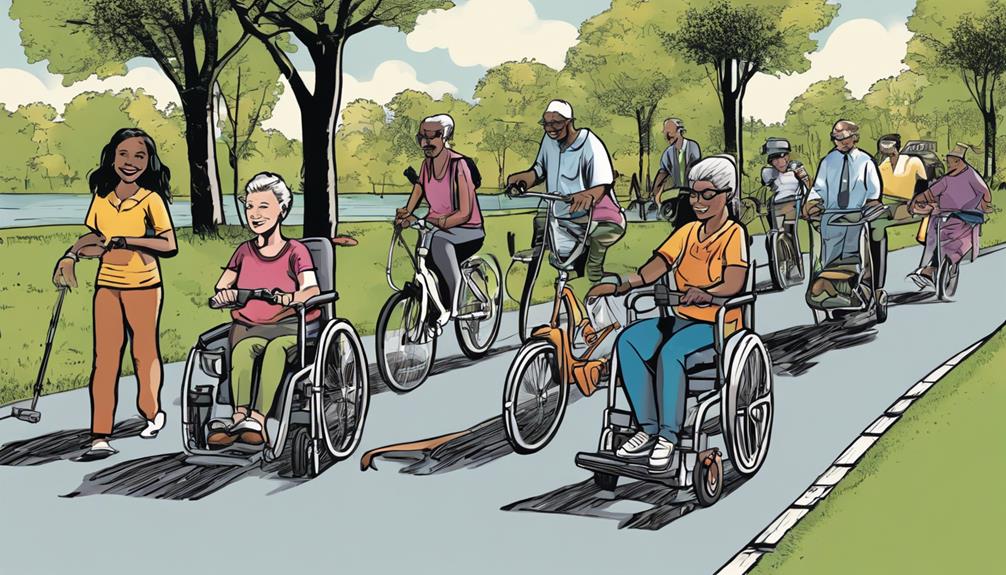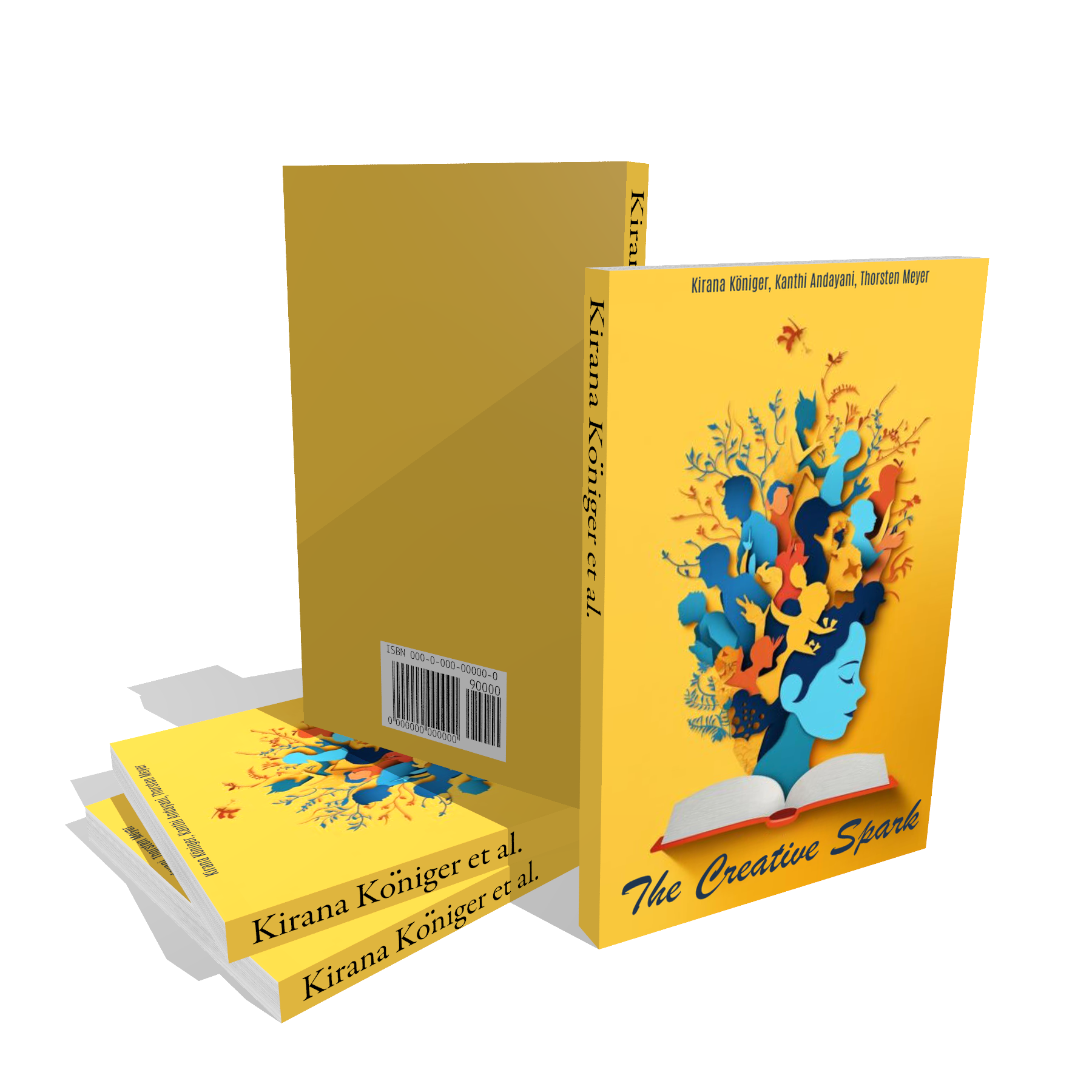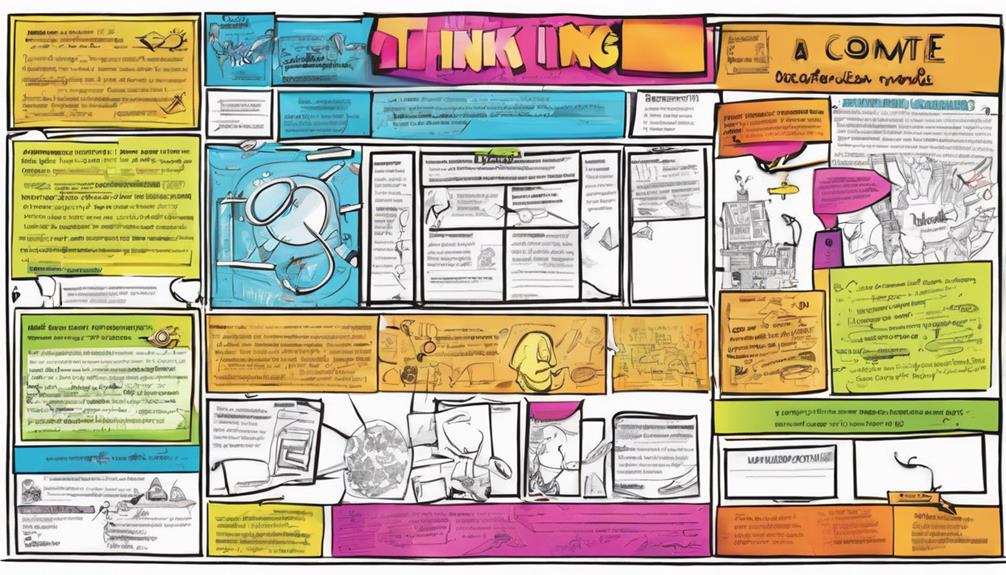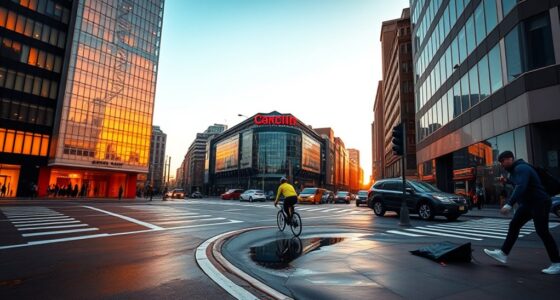Visualize your design process efficiently through storyboarding. Unite stakeholders, guide problem-solving, and innovate with visual user journey narratives. Gain insights and align teams effectively. Save time and money by resolving disagreements early. Want to explore more benefits and techniques for enhanced design thinking approaches?
Key Takeaways
- Storyboarding visually represents user journeys.
- It aligns stakeholders around design solutions.
- Visual storytelling aids in problem-solving.
- Storyboarding fosters collaboration and innovation.
- Effective design thinking through visual narratives.
Importance of Storyboarding in Design Thinking
Storyboarding plays an important role in design thinking by visually uniting stakeholders and guiding problem-solving processes effectively. By creating visual representations of the user journey, storyboarding helps teams align around user outcomes and experiences. It serves as a powerful tool for saving money and resolving disagreements early on, making it integral to driving cost-effective innovation methodologies like design sprints.
Through storyboards, teams establish a shared starting point for design decisions, allowing them to brainstorm and iterate on product UX and functionality. Unlike focusing solely on the product's UI, storyboarding in design thinking centers on mapping out the user's journey through visual storytelling. This approach not only fosters better understanding of user needs but also aligns organizations around these user journeys, facilitating informed decision-making before investing in prototypes.
Effective storyboarding ensures that everyone involved is on the same page, leading to more successful and user-centric design solutions.
Storyboarding Process Overview
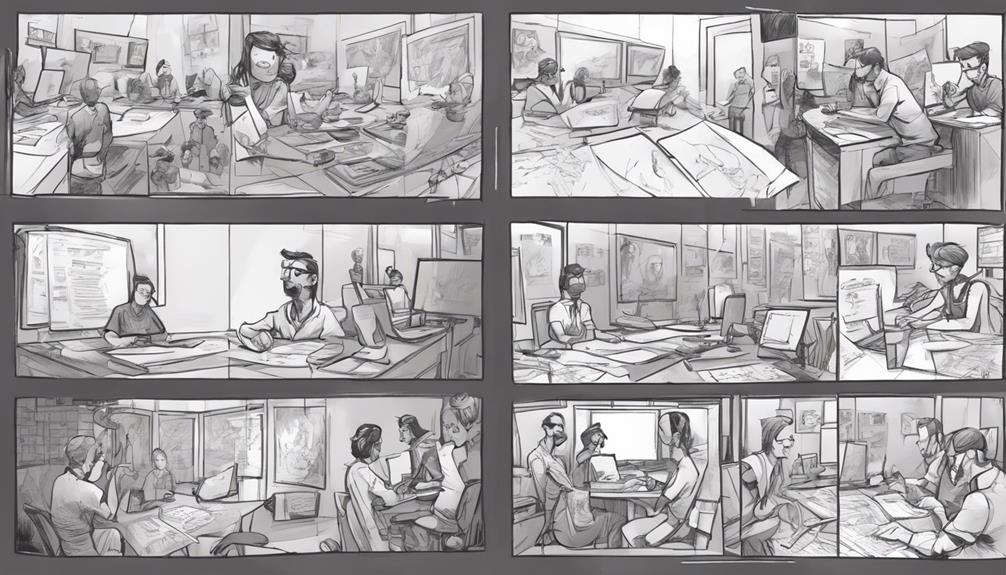
To understand the storyboard process in design thinking, consider how it distills user problems into a visual narrative for brainstorming product UX and functionality. Storyboarding is a visual representation of user journeys, focusing on the user's experience rather than the product's UI.
It serves as a common starting point for design decisions, aligning stakeholders around user outcomes and saving money by addressing disagreements early on. Essential for design sprints, the storyboard process involves mapping user journeys, emphasizing user empathy, and visually collaborating to solve problems effectively.
By aligning organizations around user journeys, storyboarding enables affordable innovation methodologies and fosters a customer-centered approach. This process not only aids in understanding user needs but also helps in creating innovative solutions that prioritize user experiences and functionality.
Through storyboarding, teams can visualize and iterate on ideas, ensuring that the final product meets user expectations and enhances overall user satisfaction.
Business Planning Essentials

You need to understand the significance of budgeting for startups and mastering market analysis techniques for effective business planning. These aspects are vital for setting a strong foundation and achieving success in your venture.
Budgeting for Startups
When budgeting for startups as part of your business planning essentials, utilize financial spreadsheets to meticulously allocate resources for your venture.
Conduct thorough user research to understand the needs and preferences of your target audience, which will help you make informed budgeting decisions.
By analyzing the budget, you can prioritize expenditures that directly address user needs, ensuring that your resources are effectively utilized.
Creating a detailed budget is pivotal for startups as it allows you to plan for various expenses such as product development, marketing, and operational costs.
By aligning your budget with your user research findings, you can tailor your financial plan to meet the specific requirements of your target market.
This targeted approach not only helps in managing your budget efficiently but also increases the likelihood of meeting user expectations and achieving business success.
Market Analysis Techniques
Market analysis techniques play an essential role in business planning by helping entrepreneurs identify target markets, competitors, and unique value propositions. To effectively analyze the market and make informed strategic decisions, consider the following techniques:
- User Interviews: Conducting user interviews allows you to gather insights directly from your target audience. Understanding their needs, preferences, and pain points can help tailor your products or services to better meet customer demands.
- User Experience (UX) Analysis: By evaluating the user experience of your website or product, you can identify areas for improvement and enhance customer satisfaction. Mapping out the user journey and addressing any friction points can lead to higher conversion rates and customer retention.
- Journey Map Creation: Creating a journey map visualizes the customer's interactions with your brand from initial contact to post-purchase. This technique helps you identify touchpoints where you can enhance the customer experience and differentiate your business from competitors.
Technology Tools for Development
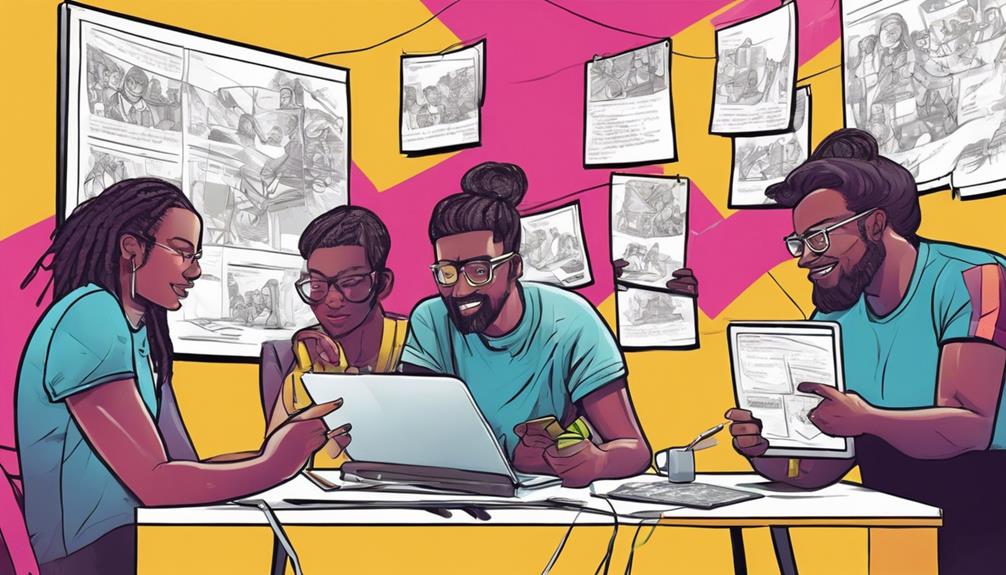
Using cutting-edge technology tools for development can greatly enhance the efficiency and functionality of your projects. When it comes to prototyping tools for designing a seamless user's journey and optimizing UX design, the following technologies stand out:
| Technology | Description |
|---|---|
| Vue.js | Ideal for creating interactive user interfaces on the front-end, enhancing user experience. |
| Node.js | Commonly used for efficient server-side scripting, handling server operations effectively. |
| React | Preferred for building dynamic user interfaces with reusable components, enhancing usability. |
| React Native | Perfect for developing mobile applications providing a native-like experience across platforms. |
| Electron | Enables the development of desktop applications using web technologies like HTML, CSS, JS. |
These tools offer diverse capabilities, from enhancing front-end interactions with Vue.js to efficient server-side operations with Node.js. React and React Native provide dynamic and reusable components for improved user interfaces, while Electron bridges the gap for developing desktop applications using familiar web technologies. By leveraging these tools, you can elevate the quality and functionality of your projects significantly.
Engagement Strategies for Success
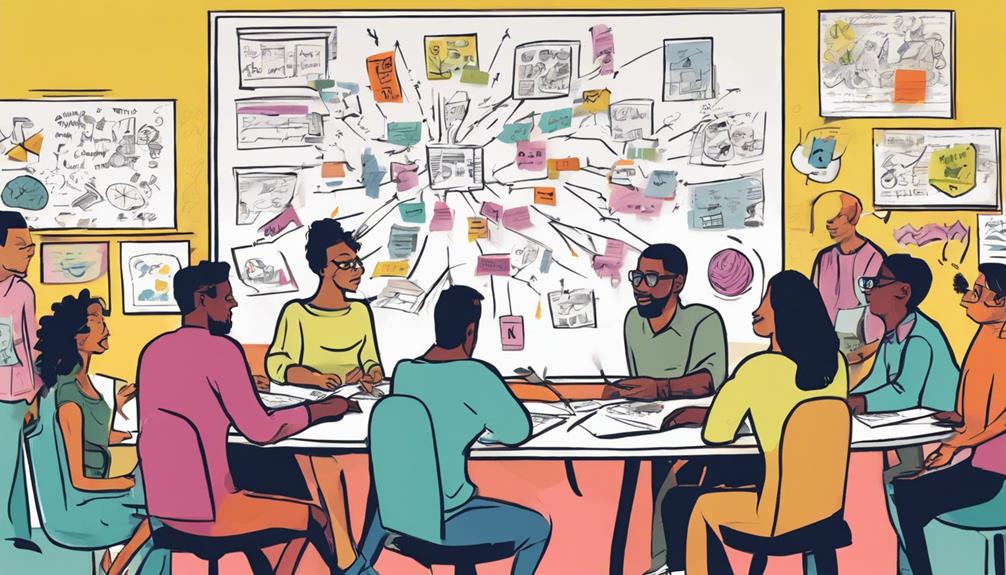
To guarantee the success of your projects, engaging stakeholders through interactive workshops is key for fostering collaboration and creativity in the design thinking process. When implementing engagement strategies, consider the following:
- Hands-On Activities: Incorporate interactive exercises that allow stakeholders to actively participate in the design process. This hands-on approach not only enhances understanding but also stimulates idea generation by immersing participants in the user's journey.
- Visual Aids: Utilize visual aids such as sketches, diagrams, and prototypes to communicate ideas effectively. Visual representations help stakeholders grasp concepts more easily and encourage them to contribute their insights and perspectives during the workshops.
- Storytelling Techniques: Create compelling narratives that resonate with stakeholders to evoke emotional responses and drive engagement. By weaving storytelling into the design process, you can captivate your audience, making them more invested in the project and committed to achieving its goals.
Understanding Storyboards in Design
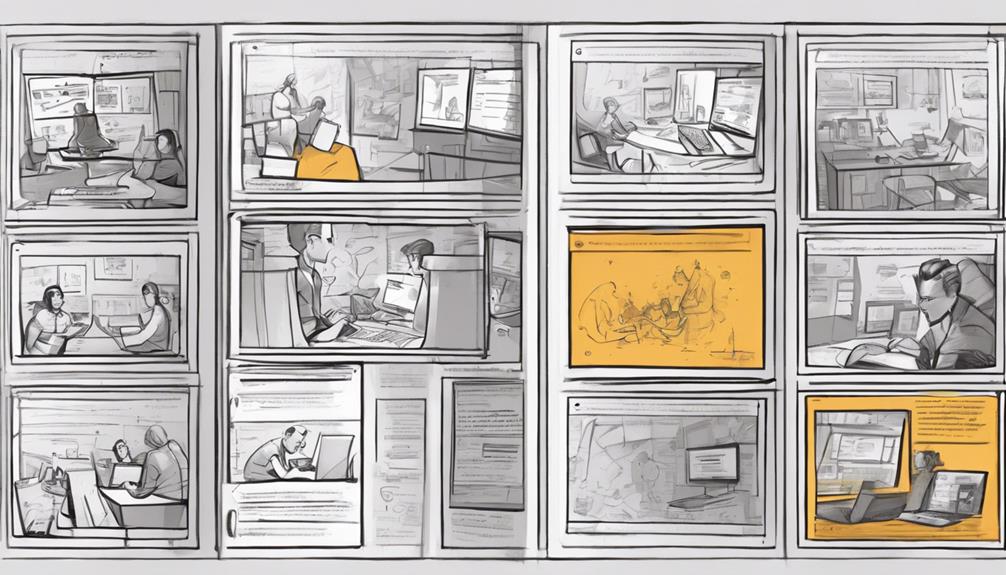
Let's break down the key elements of storyboards.
Analyzing their impact on storytelling is crucial.
It's important to compare different visualization techniques.
Understanding these points will enhance your ability to effectively communicate user journeys and design concepts through visual narratives.
Storyboard Elements Overview
An important aspect of understanding storyboards in design is grasping the foundational elements that make up these visual narratives.
When creating a storyboard, consider the following key elements:
- User's Journey: Storyboards depict the user's journey through a series of frames, capturing their interactions, emotions, and experiences. By showcasing the user's perspective, designers can empathize with their needs and pain points, leading to more human-centered solutions.
- Design Ideas: Each frame in a storyboard represents a different design idea or concept aimed at addressing specific user needs. These ideas are visualized to explore various solutions and generate innovative design alternatives.
- Shared Understanding: Storyboards foster shared understanding among team members and stakeholders by providing a visual reference that aligns everyone on the project's goals and user-centric approach. This shared vision enhances collaboration and guarantees that design decisions are made with the user in mind.
Understanding these elements is pivotal for leveraging storyboards effectively in the design process to communicate ideas, prioritize features, and drive impactful design solutions.
Storytelling Impact Analysis
Understanding the impact of storytelling in design through storyboards is crucial for creating compelling and effective user experiences. By focusing on the user journey, storyboards help align stakeholders around user outcomes, fostering agreement early in the design process and preventing costly disagreements later on.
They serve as a common starting point for design decisions, enabling organizations to brainstorm product functionality effectively. Storyboards in design thinking not only aid in problem-solving scenarios but also enhance user empathy, stakeholder recall, and decision-making based on a shared understanding of the user journey.
Through the visual representation of user experiences, storyboards create a tangible narrative that guides the design process and guarantees that the final product meets user needs effectively. By leveraging storyboards, designers can craft solutions that resonate with users and stakeholders alike, driving innovation and success in product development.
Visualization Techniques Comparison
Comparison of visualization techniques in design thinking provides valuable insights into the effectiveness of different methods for creating compelling storyboards that communicate user experiences efficiently.
When creating storyboards for a digital product, considering the following can help you choose the best visualization technique:
- User Journey Clarity: Evaluate how well each technique captures the user journey. Sketches may be ideal for rough ideation, while prototypes offer a more interactive experience.
- Visual Impact: Consider the visual appeal and clarity of the technique. Wireframes might be precise in detailing interface elements, whereas sketches convey a more conceptual feel.
- Collaboration and Iteration: Think about the ease of collaboration and iteration each technique allows. Prototypes facilitate user testing and feedback incorporation, while sketches enable quick iterations during brainstorming sessions.
Selecting the right visualization technique for your storyboard depends on the specific requirements of the project, the depth of detail needed, and the stage of ideation or development.
Benefits of Storyboarding Techniques
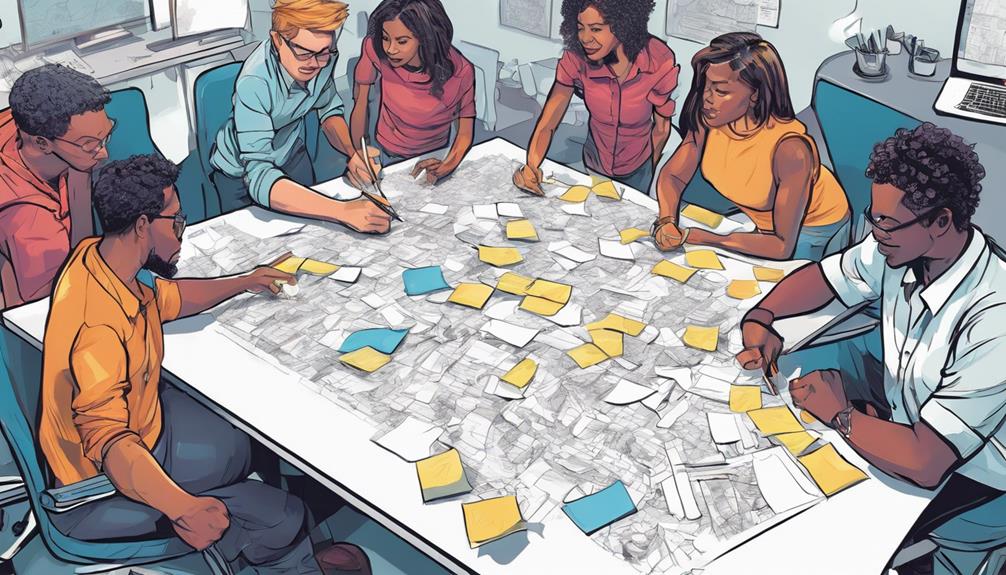
Utilizing storyboarding techniques enhances idea visualization and fosters collaborative innovation in design processes. By mapping out the user journey through visual storytelling, you can effectively communicate complex concepts and interactions.
Group activities such as brainstorming sessions and design workshops become more productive when ideas are visually represented, allowing for a shared understanding among team members. Additionally, storyboarding aids in user testing by providing a clear visual guide for gathering feedback and iterating on design solutions.
Storyboarding not only accelerates the comprehension of concepts but also facilitates the integration of diverse perspectives, leading to more well-rounded and innovative solutions. In software development, visualizing user experiences through storyboarding makes functionalities easier to grasp and refine.
Furthermore, the use of storyboarding techniques enables cost-effective changes and the exploration of new technologies before final implementation, ultimately streamlining the design process and enhancing the overall quality of the final product.
Tips for Effective Storyboarding

To create impactful storyboards, focus on visually depicting the user's journey and key interactions in a sequential manner. Effective storyboarding hinges on these tips:
- Understand the User's Journey: Begin by empathizing with the user to grasp their needs, motivations, and pain points. By outlining the user's journey, you can align your storyboard to address these aspects effectively.
- Emphasize Visual Representation: Utilize visuals that are clear, concise, and engaging. Visual elements shouldn't only illustrate the interactions but also evoke emotions and provide context for a deeper understanding of the user's experience.
- Foster Shared Understanding: Guarantee that all stakeholders involved in the design process comprehend the storyboard. Encourage collaboration and feedback sessions to refine the storyboard and cultivate a shared vision for the final design solution.
Impact of Storyboarding Practices
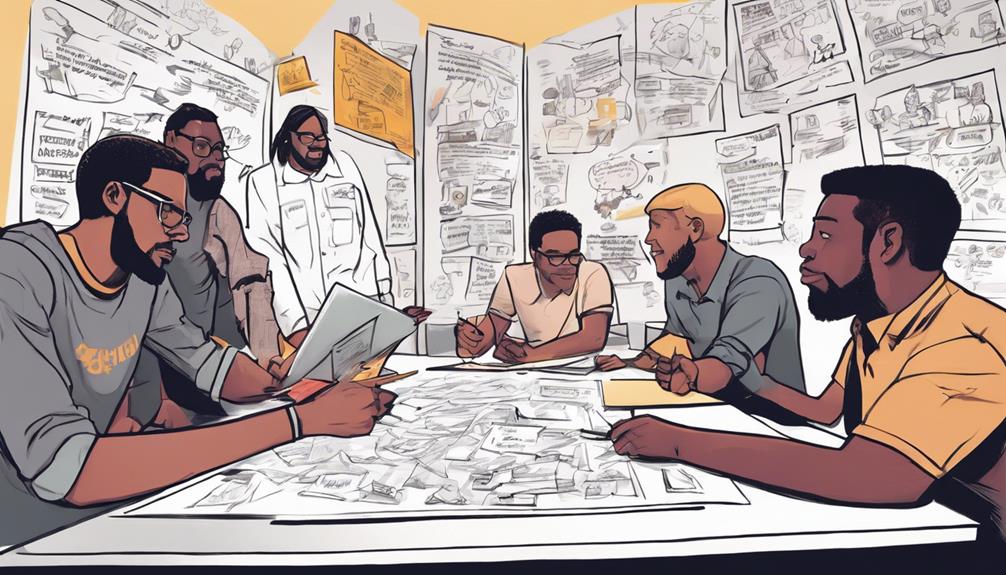
Storyboarding practices greatly enhance user empathy and stakeholder engagement by fostering a deeper understanding of user needs and behaviors in design processes. By creating journey maps that visualize the user's emotional highs and lows throughout their interaction with a product or service, designers can identify key pain points and opportunities for improvement.
This visual representation of the user's experience allows stakeholders to empathize with user frustrations and successes, leading to more impactful decision-making.
Through effective storyboarding techniques, stakeholders benefit from improved recall of specific user scenarios, enabling them to grasp the intricacies of user behavior drivers. Regular practice of storyboarding not only enhances storytelling skills but also contributes to more compelling design narratives that resonate with users on a deeper level.
Incorporating Storytelling and Visualization
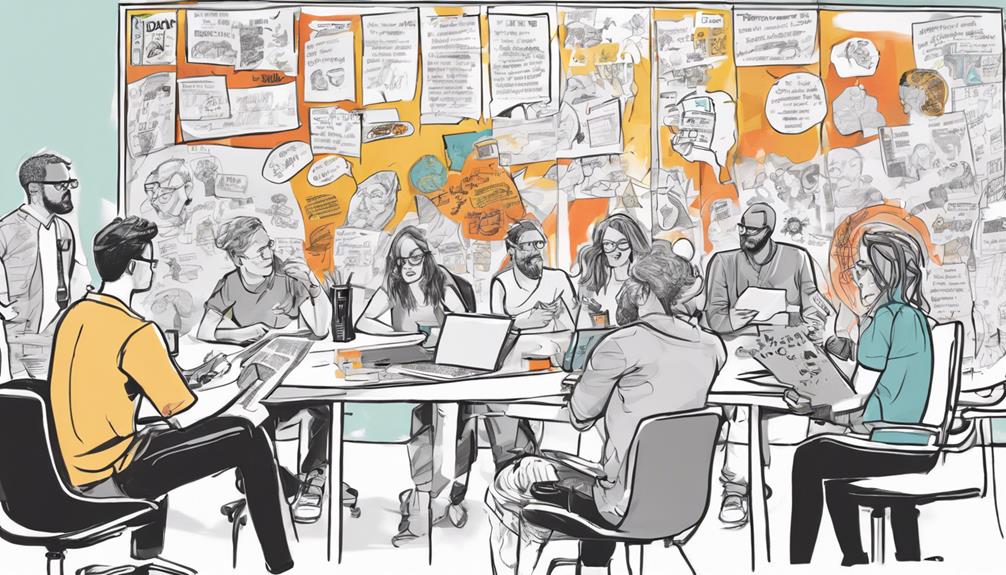
You can enhance the impact of your design narratives by incorporating storytelling and visualization techniques.
By weaving compelling narratives based on user personas and journey maps, you can engage stakeholders and garner support for your design solutions.
Integrating visualization elements like wireframes and prototypes further strengthens your storytelling, ensuring clear communication and fostering empathy.
Narrative Impact Enhancement
Enhancing narrative impact in design incorporates the powerful elements of storytelling and visualization techniques. By integrating these aspects effectively, you can create compelling design solutions that resonate with your audience.
Here's how to boost narrative impact in your design process:
- Leverage User Personas: Crafting narratives that align with user personas guarantees that your design solutions address the specific needs and preferences of your target audience.
- Utilize Visualization Techniques: Visualization tools such as wireframes and prototypes help translate abstract narratives into concrete visuals, aiding in a better understanding of the design concept.
- Iterate Based on Feedback: Feedback drives the iterative process of narrative enhancement. By incorporating feedback from stakeholders and users, you can refine your design narratives to guarantee they're impactful and resonate with the intended audience.
Visual Elements Integration
Integrating visual elements with storytelling enhances the impact and effectiveness of design solutions in engaging users and stakeholders. By incorporating user personas and journey maps into the narrative, you can create a more personalized and relatable experience for your audience.
User personas help you understand the needs and preferences of your target users, while journey maps visualize the user's interactions with your product or service. Additionally, using wireframes can further enhance the storytelling process by providing a visual representation of the design concept.
Looking at Tesla's approach, integrating customer stories into their branding strategy has proven to be highly effective in capturing the audience's attention and building a strong emotional connection. This showcases the power of combining storytelling with visualization to create a compelling narrative that resonates with users.
Frequently Asked Questions
How to Storyboard in Design Thinking?
To storyboard in design thinking, start by mapping the user journey visually. Capture key moments, pain points, and solutions. Collaborate to refine the story. Remember, it's about the user experience, not just the interface.
How Do You Visualize a Storyboard?
To visualize a storyboard, sketch key interactions, emotions, and decisions in sequential frames. Use simple drawings, captions, and symbols for effective storytelling. Align with your team on user experiences, identify pain points, and brainstorm solutions visually.
What Are the 4 Main Styles of Storyboards?
Imagine painting a canvas of imagination with storyboards. Grid, vertical, horizontal, and thumbnail styles offer diverse ways to showcase your ideas. Each style, like colors on a palette, brings your narrative to life.
How Do You Storyboard an Idea?
To storyboard an idea, outline the user journey in visual frames. Depict scenarios highlighting user actions and emotions. Use stick figures or digital tools. Iterate based on feedback for a refined solution that aligns stakeholders and fosters collaboration.
Conclusion
As you set sail on your design thinking journey, remember that storyboarding is your compass, guiding you through the creative process.
Just like a ship relies on its map to navigate the vast ocean, your storyboard will lead you to your destination of innovative solutions.
Embrace the power of visualization and storytelling to bring your ideas to life, and watch as your designs flourish and evolve into something truly remarkable.
Trust in the process and let your creativity set sail.

